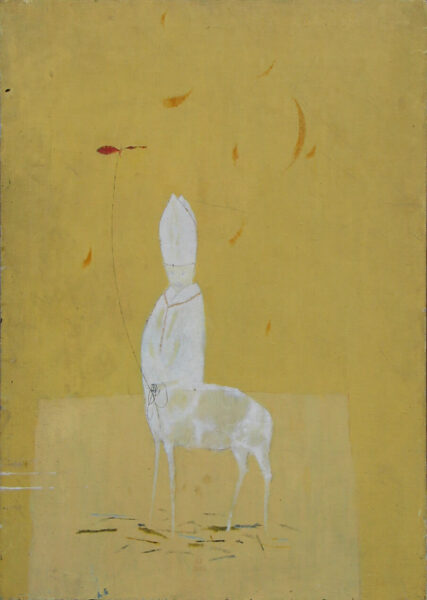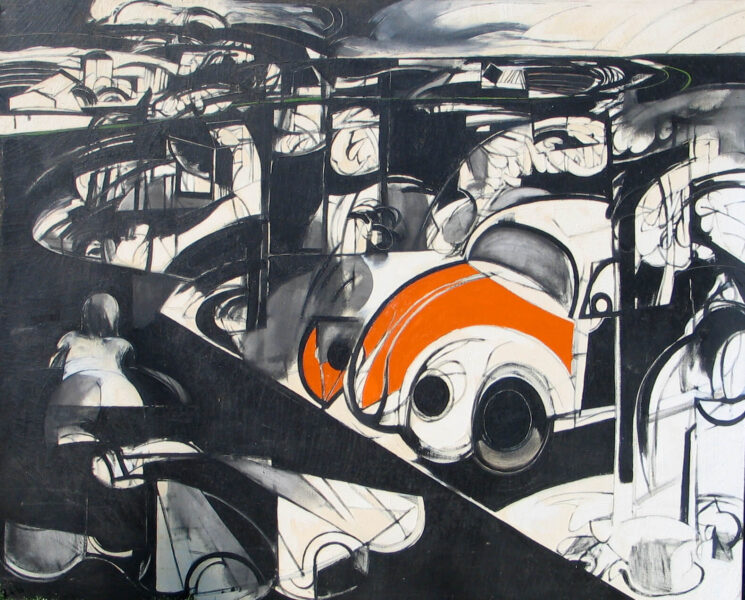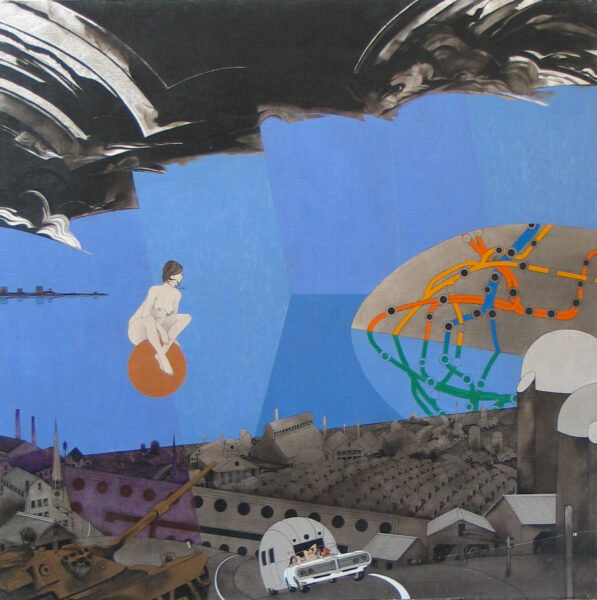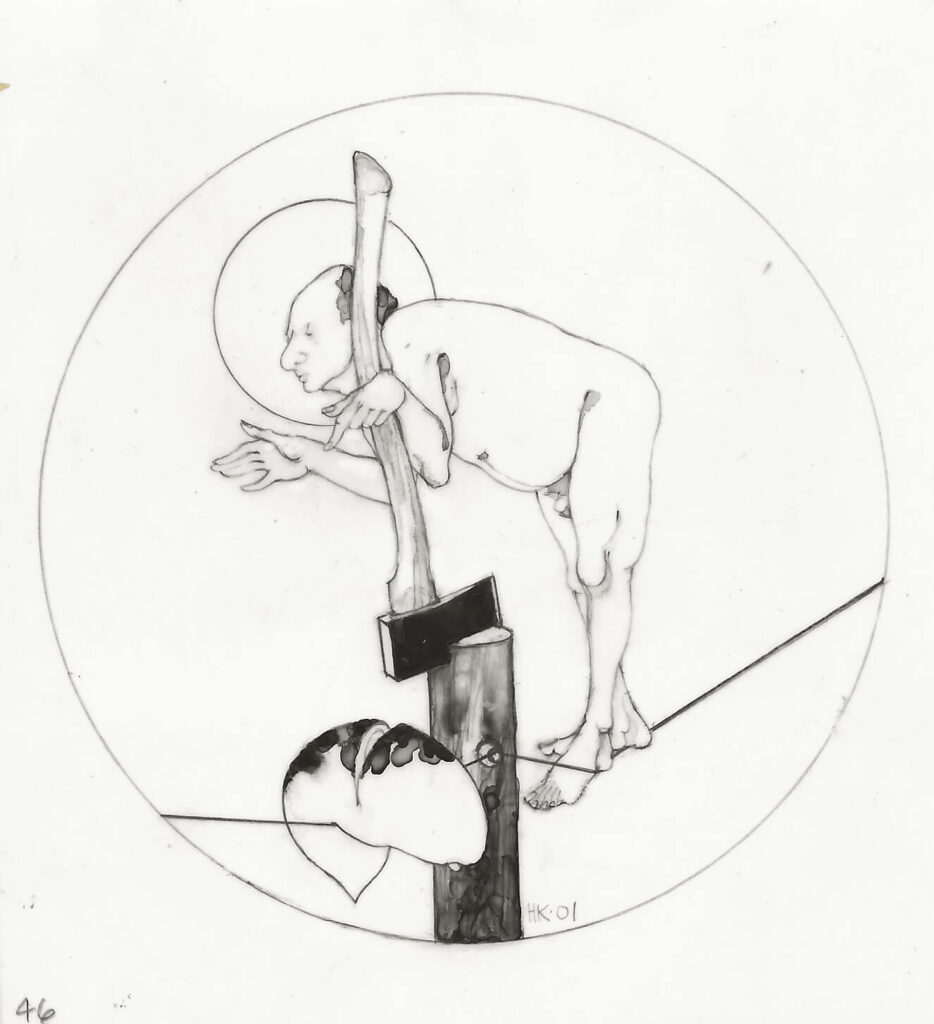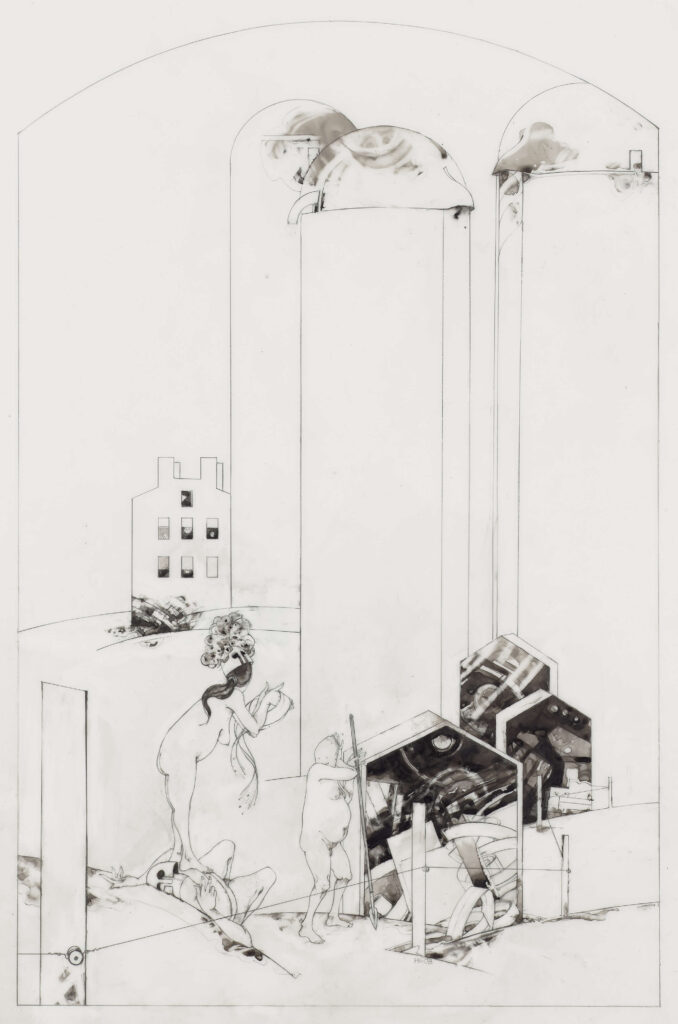Arkansas Years: late 1940s to early 1960s
Harold Keller received a BA in art and philosophy from the University of Arkansas in 1949, studied for his Master’s Degree at NYU in the 1950s, and from 1956-1962 taught art and philosophy at Fort Smith Junior College (now a campus of the University of Arkansas). A 1946 graduate of Brooklyn Technical High School, his early work was influenced by his Jewish upbringing, the humor of Saul Steinberg, the paintings of Paul Klee, German graphic arts of the late 15th century, Jewish mysticism, Christian symbolism and a penchant for classical themes such as the Birth of Venus. His art is delicately figurative until 1960, when, at the suggestion of his NYU instructor, Hale Woodruff, he turns to collage, with abstract images of female bathers on Brighton Beach in Brooklyn.
New York City Years: the 1960s
Broadly brushed paintings of women riding the New York City subway grow from the collages of the early 1960s. Inspired by W.H. Auden’s poem “Musée des Beaux Arts”, in which daily life continues as major events occur, the Birth of Venus blossoms. She rises from her shell in Birth of Venus with a Yellow Submarine, poses with her half-shell on highways next to a dump truck, a VW Beetle, a Karmann Ghia or a John Deere tractor. By the end of the 1960s she is found in complex landscapes reminiscent of Brueghel, where New York City buildings and bridges rise in the background, and upstate New York farms dominate the foreground, where Venus rises from a pond, or the Battenkill.
Portals onto Other Worlds: the 1970s
Set in complex landscapes that have been described as “portals” onto another world, the paintings of the 1970s teem with military tanks camouflaged like Holstein cows, maps of parks and subway lines, floorplans of cathedrals and Greek temples with skies dominated by parallelograms of local showers where angels abound. Biblical subjects such as The Annunciation, the Four Horsemen of the Apocalypse, Abraham and Isaac and the Expulsion from the Garden happen in corners of these complex compositions. Angels accompany the stages of the winds, appear to the Virgin Mary as she slogs back to the house from milking the cows, and swoop down on Adam and Eve, interrupting them busy with their red rototiller in the Garden of Eden. Everything is crisply painted, the broader handling of the 1960s has been left behind.
Nemesis and her Aircraft: the 1980s
The mythological figures of Tyche and Nemesis appear often in the paintings of the late 1970s. In the 1980s, the goddess of fortune and the goddess of retribution, dominate the paintings, which are frequently circular in shape. Inspired by Albrecht Dürer’s 1502 engraving of the winged Nemesis, who travels on her celestial globe, holding a bridle to bind man’s pride and a goblet containing rewards for the just, Keller’s Nemesis, who does not have wings, rides her celestial globe in close collaboration with aircraft, clutching her shopping bag (instead of a goblet) and a lasso (rather than a harness). She soars over sepia farm landscapes, often over a sea on which a container ship, on its entry into New York Harbor, shows a horizon line at its stern, but not at its prow.
Angels and Witches: 1990-1997
From 1990 to 2015, the artist made drawings using pencil with ink washes, using mylar, a type of plastic once used by architects to create blue prints, as a support. Unlike paper, it takes multiple corrections well – the artist was charmed that ink washes could be removed with Windex.
Series of drawings dominate, with angels, often accompanied by aircraft, aloft over Brighton Beach, various stops on the London Underground and the New York City Subway System, or witches riding their broomsticks over Rte. 29 near Greenwich, New York.
Groups of angels constitute many of the series, such as the Angels of the Days of the Week or the Angelic Governors of the Twelve Signs of the Zodiac. Groups of witches are on their way to the sabbat, showing off to each other as they ride three-legged stools or broomsticks while stopping at traffic lights.
The Archangel Michael fights Satan: 1996-2006
The Archangel Michael’s battle with evil dominates the drawings of these years. The fight always takes place at the top of an electricity pole with the Archangel wielding various weapons: a scythe, an axe, a sword or a pruning knife. Satan starts out as a rather winsome floppy eared snake-like creature. By 2006, Satan is a large slug, not in the least winsome. Some drawings show the two fighting, sometimes they’re resting and, just occasionally, it appears that the Archangel has won. There is a humorous undercurrent to the drawings but this is always a fight the Archangel intends to win.
The Iliad and the Angels of the Four Winds: 2007-2015
The Iliad drawings deal with Homer’s telling of the tragic death of Hector, here played out against a backdrop of upstate New York farm silos. Athena figures prominently, with her helmet set rakishly so as not to disturb her ponytail. The drawings featured here are part of a group of 32, and was the result of a careful reading in the Rieu translation of Hector’s death at the hands of Achilles (and Athena).
The manipulation of the Greeks and Trojans by the gods and goddesses fascinated him because these beings were invisible. How do you draw that?
The artist’s last finished group of drawings depicts the Angels of the Four Winds. Squatting atop farm silos, Michael, Raphael, Gabriel and Uriel are shown as old men who grasp their weapons tightly as they wait for the enemy, which is death. The drawings are significant in that, the artist departed from the normal ordered cleanliness of his drawings by deliberately grinding dirt into the mylar. He wrote of these drawings “Silos, Dirt, Bugs, Dust”.
